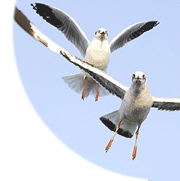Deck that Gull
Guano is the mother of invention
by Maureen Miller

Resilient seabirds, fantastic in flight but foul when perched, gulls come from a big family. Of the 87 birds in the avian family Laridae, 50 are gulls. That’s a lot of gulls, from the common grey-and-white herring to the squid-eating, night-feeding swallow-tailed gull of the Galapagos Islands.
Several species frequent Chesapeake Bay, including the impressive great black-backed, with its massive yellow bill and up to five-foot wingspan; the basic herring gull; the abundant wintering ring-billed gull, with black ring near the tip of its yellow bill; and the laughing gull, which lives up to its name and sports a black hood when breeding.
No gull is choosy about meals. Scavengers by design, these birds feast off stuff we discard. Kleptoparasitic by nature, they flourish by robbing from others.
Humans are little choosier. During the 17th and 18th centuries, many a gull graced the tables of the great houses of Europe. Early North American settlers brought with them the taste not only for gulls’ flesh but also for their eggs. What the appetites of lords, ladies and settlers didn’t do to wipe out gull populations, the millinery trade did — using not only the feathers but also whole birds to decorate ladies’ hats.
When scrubbing gull droppings from your deck, you may relish the thought of scrambling a gull egg or two or collecting a few feathers for your cap. But you must put those thoughts aside. By the late 1880s, gulls were pushed to the brink of extinction — until outraged ornithologists intervened with protective legislation.
The North American natives have used their remarkable ability to adapt to flock to almost every part of world. While exact numbers of gulls worldwide are elusive, thriving congregations hover along shorelines as well as on city streets, farmers’ fields and garbage dumps.
Since the gulls’ comeback, complaints have soared. These federally protected migratory birds screech day and night, disassemble garbage cans and befoul our beaches, boats and piers with their guano. Humans have fought back with creative deterrents. As you return to life outdoors and on the water, consider a range of repellents to ward off the ubiquitous gull:
Fortify your fleet. The English company Jones&Sons, The Gull Deterrent People, recommend seagull spikes. When adhered to your deckhouse or dock, these strips of densely patterned protruding pins make it uncomfortable for birds to touch down. Birdbusters.com sells Bird Coil, practically invisible, stainless steel, coiled wire to destabilize any ledge-type landing platform.
Work with nature. More humane deterrents include plastic or rubber snakes, Mylar flags, multiple burgees and monofilament fishing line strung from mastheads to spreaders to keep gulls off.
Get a pet. Boater Mary Bryce endorses her 14-pound Russian blue cat that walks on a leash. Birdsoffboats.com recommends the lower maintenance Daddi Long Legs, a cylindrical gadget with long stainless-steel, plastic-tipped arms that rotate and wave menacingly in the slightest breeze.
Make a commotion. Try the Bird Chase Supersonic, a speaker system featuring 22 different bird distress calls. If that doesn’t keep the birds away — and your crew awake — check out a six-pack of Bird JUMPO. Use these devious devices to create a mini-minefield. Then watch the JUMPOs jump, snap and leap at unsuspecting birds — and sleepy crew members.
Conduct your own research. Floridian Capt. Sam Bell swears by his trusty owl replica on the spreaders, but two Californian sixth graders found the owl to be worthless. Their thorough research determined the most effective deterrent to be the Gull Sweep, a small horizontal windmill device.
Go for power. The most persuasive award, however, goes to Jim Stuart of York Harbor, Maine. Stuart wired his mast and spreaders with a 30,000-volt electric fence charger and embellished it further with 20 18-gauge hypodermic needles embedded in small blobs of silicone cement. If the gulls don’t get a charge out of this, they are sure to get the point: no guano here.
Former Galesvillian Maureen Miller enjoys crewing along the waterways from Maine to the Bahamas. But it takes a bigger bribe than beer to clean guano off her captains’ deck. Her last story for Bay Weekly was “Going South,” on osprey and snowbirds (Vol. 15, No. 47: Nov. 22, 2007).